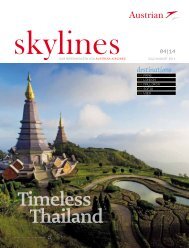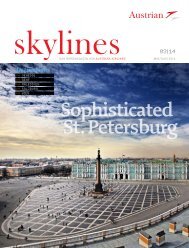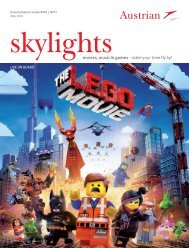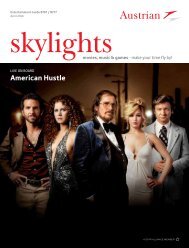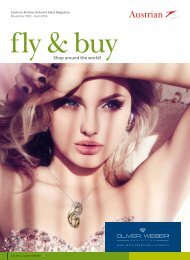Erfolgreiche ePaper selbst erstellen
Machen Sie aus Ihren PDF Publikationen ein blätterbares Flipbook mit unserer einzigartigen Google optimierten e-Paper Software.
ÖSTERREICH<br />
DORIS KNECHT<br />
Österreich für Anfänger: das Wiener Kaffeehaus<br />
Austria for Beginners: the Vienna Kaffeehaus<br />
DORIS KNECHT<br />
ist Kolumnistin<br />
bei der Tageszeitung<br />
Kurier und der Wochenzeitung<br />
Falter. Ihr neuer<br />
Roman „Besser“ ist bei<br />
Rowohlt Berlin erschienen.<br />
DORIS KNECHT is a<br />
columnist for the daily<br />
Kurier and the weekly<br />
Falter. Her new novel,<br />
“Besser”, has been<br />
published by<br />
Rowohlt Berlin.<br />
Das Kaffeehaus sorgt<br />
für Privatsphäre und<br />
Anonymität.<br />
The coffee house<br />
guarantees privacy and<br />
anonymity.<br />
Mehr wienerisches Wien als das<br />
Kaffeehaus geht bekanntlich nicht.<br />
Das Kaffeehaus. Sinnbild und Herberge für<br />
alles, was mit wienerischer Mentalität und<br />
Wiener Tradition zusammenhängt: Muße,<br />
Gemütlichkeit, intellektueller Tratsch, die<br />
Wiener Raunzerei, die Kaffeehausliteratur,<br />
die s. g. Kaffeehausintellektuellen.<br />
Und dann natürlich der Kaffee: die<br />
Melange, der Große Braune, der Kleine<br />
Braune, der große und der kleine Schwarze,<br />
der Verlängerte, der Einspänner (nicht,<br />
dass der Wiener oder die Wienerin den je<br />
trinken würden, derlei konsumieren<br />
ausschließlich Touristen und andere<br />
Wien-Besucher). Das Glaserl Wein. Das<br />
Gulasch und das Seidel Bier (das kleine<br />
Bier, so heißt es hier.) An alkoholfreien<br />
Tagen: der Pfiff (ein derart winzig kleines<br />
Bier, dass es in Wien nicht als Alkohol gilt).<br />
Und der Schinken-Käse-Toast, eine Speise<br />
auf Fett-und-Kohlenhydrate-Basis, die z.B.<br />
Ihre Autorin weder zubereiten noch<br />
konsumieren würde, außer im Kaffeehaus;<br />
im Kaffeehaus immer. Das Kaffeehaus<br />
heißt im Übrigen meistens „Café“, man<br />
sagt aber trotzdem: „Ich geh ins Kaffeehaus.“<br />
Oder ins Prückel, ins Hummel, ins<br />
Ritter, ins andere Ritter (das in Ottakring<br />
nämlich, in dem der legendäre Fußballer<br />
und Trainer Ernst Happel immer saß), ins<br />
Weingartner, ins Hawelka, ins Sperl, ins<br />
Café Museum (hier Ausnahme wegen<br />
Verwechslungsgefahr mit der Institution),<br />
ins Westend, ins Wortner, ins Bräunerhof<br />
(Thomas Bernhards Lieblingskaffeehaus,<br />
wer sich erinnert) oder in eines der hundert<br />
anderen in ganz Wien.<br />
Wichtig im Kaffeehaus, natürlich:<br />
Zeitungen. Viele Zeitungen, großformatige<br />
Zeitungen. Die Zeitungen werden – so war<br />
es immer, so muss es sein – in riesige,<br />
eigentlich recht unhandliche Rattan- oder<br />
Holz-Draht-Geflechte eingespannt, die<br />
REDAKTION: MANUELA PRUSA<br />
unten einen Griff haben und die man post<br />
Lektüre an Garderoben- oder anderen<br />
Haken aufhängt. Auf diese Weise sorgt das<br />
Kaffeehaus auch für Privatsphäre und<br />
Anonymität: Denn hinter so einer Zeitung<br />
ist man so hinreichend verdeckt und<br />
ungestört wie hinter einem Paravent.<br />
Daheim unter Leuten.<br />
Wofür das Wiener Kaffeehaus noch<br />
berühmt und berüchtigt ist: Es ist vielleicht<br />
die einzige gastronomische Institution auf<br />
der Welt, in der es dem Personal erlaubt ist,<br />
arrogant gegenüber der Kundschaft zu<br />
sein. Gegenüber „der Kunde“, wie es in<br />
Wien heißt. Ein grantiger Ober – also<br />
Kellner – hat seit je zum Kaffeehaus gehört<br />
wie die Melange. Allerdings ändert sich das<br />
allmählich: zum Glück. Denn nicht einmal<br />
mehr Kummer gewohnte Wienerinnen<br />
und Wiener wollen es sich noch gefallen<br />
lassen, im Lokal unfreundlich und von<br />
oben herab behandelt zu werden und<br />
dafür auch noch zu bezahlen. Wien-<br />
Besucherinnen und -Besucher sowieso<br />
nicht, da sie meist aus Ländern angereist<br />
sind, in denen zuvorkommende Freundlichkeit<br />
als Teil der Dienstleistung<br />
betrachtet wird. Erstaunlicherweise greift<br />
diese Idee nun auch in Wien, und vor allem<br />
in den neuen oder modernisierten<br />
Kaffeehäusern gehört ein freundlicher Ton<br />
endlich zum Standard. Zum Beispiel im<br />
Café Drechsler am Naschmarkt, einem<br />
Vorzeige-Beispiele dafür, dass etwas<br />
derartiges wie ein modernisiertes,<br />
modernes und dennoch typisches<br />
wienerisches Kaffeehaus existiert. Denn<br />
das Drechsler war immer schon eine<br />
Institution: ein Ort, an dem man zu jeder<br />
Tageszeit frühstücken und sich, nach einer<br />
durchzechten Nacht, schon um vier Uhr<br />
früh mit einem Gulasch und einem Seidel<br />
Bier stärken konnte. Denn während all die<br />
anderen wunderbaren neuen Lokale, die<br />
FOTOS: DEA / A. DAGLI ORTI/ GETTY IMAGES<br />
Wien in den letzten Jahren noch lebenswerter<br />
machen, so wie sie sind auch in<br />
Berlin, London oder New York eröffnen<br />
könnten, gibt es das Kaffeehaus nur in<br />
Wien. Ein Ort, an dem Menschen aller<br />
Schichten bei Kaffee und Wasser stundenlang<br />
plaudern können.<br />
///<br />
It’s well-known that few things in Vienna are<br />
more Viennese than the city’s Kaffeehaus, or<br />
coffeehouse. Ah, the Kaffeehaus. Symbol and<br />
home of all that we like to associate with the<br />
Viennese mentality and the city’s traditions: a<br />
love of leisurely life, Gemütlichkeit, intellectual<br />
tittle-tattle, the Viennese grumble, Kaffeehaus<br />
literature, and the city’s so-called ‘Kaffeehaus<br />
intellectuals’.<br />
Then there is the coffee itself, of course, which<br />
comes in a range of different versions: the<br />
mélange, the großer and kleiner Brauner (single<br />
and double mocha respectively, with a splash of<br />
milk), the großer and kleiner Schwarzer (the same<br />
thing, without the milk), the Verlängerter (that<br />
mocha with milk again, but stretched with<br />
water), the Einspänner (in a glass and topped<br />
with whipped cream, a version the Viennese<br />
themselves would never dream of drinking, and<br />
consumed only by tourists and other visitors).<br />
There’s a glass of wine. Goulash, and the ‘Seidl<br />
Bier’ (as a small beer is known here.) On days<br />
when you’re avoiding alcohol, you can have a<br />
‘Pfiff’ (a sort of tiny little beer which isn’t counted<br />
as alcohol in Vienna). Then there’s the ham-andcheese<br />
toast, a delicious hand grenade of fat and<br />
carbohydrates which your writer would not dream<br />
of preparing or consuming anywhere other than in<br />
a Kaffeehaus. When at the Kaffeehaus, she would<br />
never order anything else.<br />
While the more international (i.e. French)<br />
term ‘café’ is used to describe small outlets in a<br />
city serving coffee, if a native of the capital ever<br />
announces he is just about to go to such a place<br />
whilst putting on his coat and heading for the<br />
front door, he will only ever use the words ‘Ich geh<br />
ins Kaffeehaus’. Alternatively, of course, he may<br />
refer to the Kaffeehaus by its actual name.<br />
Examples of institutions include the Prückl, the<br />
Hummel, the Ritter, the andere Ritter (literally<br />
‘the other Ritter’, a Kaffeehaus in the district of<br />
Ottakring where legendary footballer and trainer<br />
Ernst Happel always used to sit), the Weingartner,<br />
Hawelka and Sperl, the Café Museum (the<br />
exception to the ‘don’t call it a café’ rule; in this<br />
case, the word is used to avoid confusion with the<br />
cultural institution), the Westend, Wortner,<br />
Bräunerhof (Thomas Bernhard’s favourite<br />
Kaffeehaus, for those who remember him), or any<br />
one of the hundreds of other such outlets dotted<br />
across the capital.<br />
Something else that is all-important at the<br />
Kaffeehaus, of course, are its newspapers. There<br />
are lots of these, and it’s broadsheet or not at all.<br />
The newspapers are inserted into long rattan or<br />
wooden tubes – this is how it has always been<br />
done, and always will be – with a handle at the<br />
bottom, so the paper can then be hung back up<br />
on a wardrobe or other such hook when the<br />
reader has finished, ready for the next. Meant to<br />
make them easier to read for many visitors, they<br />
are in fact incredibly unwieldy. In this way,<br />
though, the Kaffeehaus is also ensuring that a<br />
high level of privacy and anonymity is maintained:<br />
when concealed behind such a newspaper,<br />
the reader remains as undisturbed as if he were<br />
actually behind a paravan. In this way, he can<br />
enjoy the privacy of home, whilst out in<br />
company.<br />
Something else the Vienna Kaffeehaus is<br />
famous for – notorious, even – is that it is quite<br />
possibly the only gastronomic institution in the<br />
world where staff are permitted to behave<br />
arrogantly towards the clientele, or ‘der Kunde’<br />
– ‘the customer’ – as he is referred to with audible<br />
disdain in Vienna. A grumpy ‘Ober’ – the waiter<br />
– is as much a part of the unique atmosphere and<br />
feel of a Kaffeehaus as the froth on a mélange.<br />
In fact, this particular tradition is now<br />
beginning to change – and not before time. These<br />
days, not even the notoriously miserable Viennese<br />
still cherish the idea of being talked down to in an<br />
unfriendly tone by the staff at their local<br />
Kaffeehaus – and then being asked to pay for the<br />
privilege. And you can be absolutely certain<br />
visitors to the city don’t like it, since most of them<br />
will have just touched down from a country where<br />
a forthcoming, friendly air is considered all part of<br />
the service. Amazingly, this idea is now also<br />
taking root in Vienna, especially at new or<br />
revamped Kaffeehäuser, where a friendly manner<br />
has finally become the norm in recent years.<br />
For evidence of this trend, you need only drop<br />
by the Café Drechsler at Naschmarkt, one of the<br />
best examples of how the Kaffeehaus has been<br />
able to successfully reinvent itself as up-to-date,<br />
modern and still very, very Viennese. The<br />
Drechsler has always been an institution. This<br />
is a place where you can have your breakfast at<br />
any time of day or night, or recover with a<br />
goulash and a Seidl Bier at four in the morning<br />
after a night on the Viennese tiles.<br />
Because while Vienna, too, boasts all those<br />
wonderful new café chains that have popped<br />
up in Berlin, London, New York and elsewhere<br />
in the past decade, and is all the better for it,<br />
the Kaffeehaus belongs to Vienna and Vienna<br />
alone. It is a place where people of all classes<br />
are free and welcome to chat for hours over a<br />
coffee with a little glass of water they don’t<br />
want just beside it.<br />
q<br />
46 | skylines 03/2014<br />
03/2014 skylines | 47



